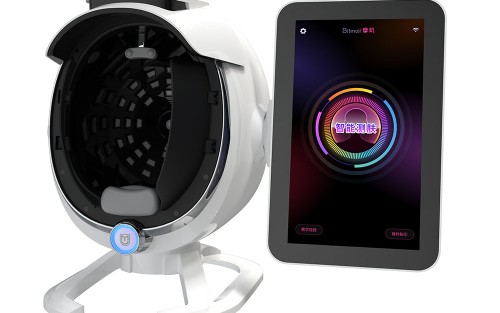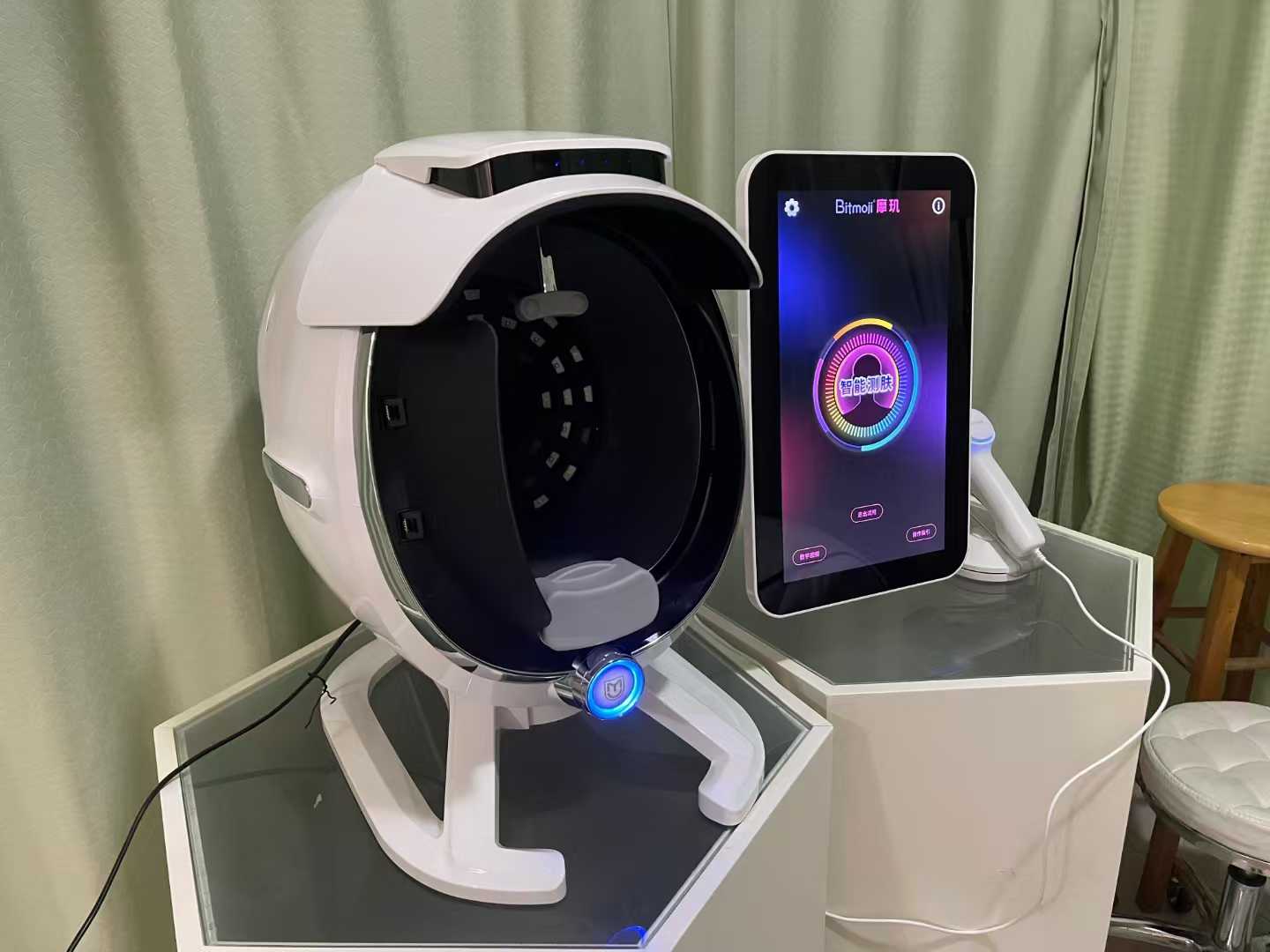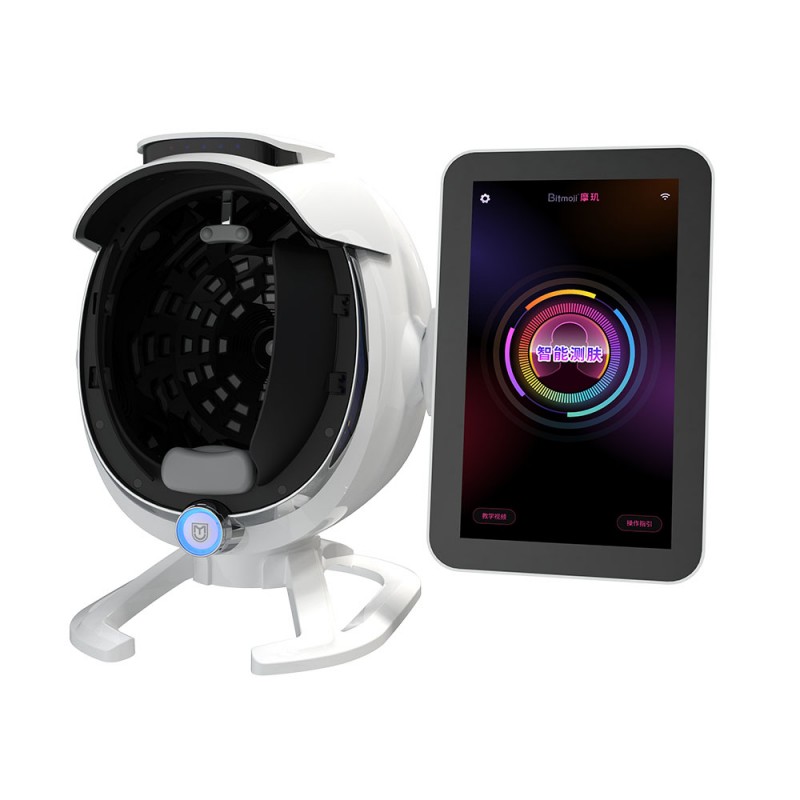
The core function of a skin analysis tool in a professional setting
Tool function positioning
The skin analysis tool uses artificial intelligence, ultraviolet imaging and multispectral scanning technology to achieve multi-dimensional quantitative detection of skin condition. Its core functions include:
- hydration value measurement
- Pigmentation distribution map generation
- skin texture analysis
- Aging characteristics recognition
- Screening for pathological features
Professional value matrix
| Core strengths | Value realization |
|---|---|
| Accurate personalized service | Formulate treatment plans based on data modeling to improve customer satisfaction (92% clinical validation data) |
| Endorsed by professional authorities | Equipped with medical-grade testing algorithms to enhance the credibility of service technology |
| Commercial value conversion | Promote the sale of treatment packages through visual reports, increasing the average customer price by 35 |
Typical application scenarios
Medical-grade applications
- Dermatology clinics: acne grading assessment/early screening for melanoma
- Medical beauty institutions: parameter setting for photodynamic therapy/tracking of post-operative results
Consumer-level applications
- High-end SPA clubs: customized care plans/product absorption tests
- Beauty counters: skin type suitability analysis/product efficacy verification
Industry trends
Modern skin analysis systems are reshaping the service paradigm in the professional skincare field by digitally connecting biometric data with treatment plans. The breakthrough lies in the establishment of a closed-loop service system of "detection-diagnosis-intervention", which has shifted personalized skincare from an experience-oriented to a data-driven model.
A guide to the core functions of professional skin analysis tools
1. Accurate technical support
- AI intelligent recognition
Uses deep learning algorithms to accurately detect 8 types of skin problems such as wrinkles, pigmentation, and pores, with an analysis accuracy of over 92% (clinical data). - Multispectral imaging system
Uses a 415nm-970nm multi-band light source to penetrate the epidermis to the superficial dermis to reveal deep-seated problems such as UV damage and red blood vessel distribution. - 3D modeling technology
combined with a 12-megapixel high-definition camera to generate a 3D map of skin texture and quantify roughness indicators.
2. Efficient workflow integration
- Cross-platform compatibility
Supports real-time shooting on iOS/Android mobile devices and seamless integration with Windows/MacOS systems. Diagnosis database - 10-minute quick file creation
From shooting to generating a professional report containing 12 indicators, the entire process is controlled and completed on a single screen of the tablet.
3. Clinical-grade reporting system
Basic Edition|Professional Edition| |---|---|---| |Testing dimensions|8 core indicators|22 skin parameters| |Comparative analysis|3 groups of historical data|unlimited comparisons| |Output format|PDF graphic report|dynamic video+3D model|
4. Personalized solution engine
- Intelligent recommendation algorithm
Automatically match photodynamic parameters, acid concentrations and other treatment recommendations based on skin type (Fitzpatrick classification) - Product cross-analysis
Built-in database of 200+ brands and ingredients to avoid contraindications in sensitive skin
5. Mobile solution
Compact equipment (≤2kg) equipped with a military-grade protective case to meet the needs of mobile scenarios such as medical beauty tours and community screenings, and supports 4 hours of offline use.
Points to consider when choosing: Give priority to devices with CFDA Class II certification to ensure the clinical validity of the test data. Regularly calibrate the color temperature calibration module to maintain test consistency of over 98%.
Types of professional skin analysis tools
1. Hardware-based tools
Technical principle
Uses technologies such as ultraviolet imaging, multispectral analysis, and high-resolution photography to directly capture deep skin data through physical equipment, and can accurately detect indicators such as wrinkles, pigmentation, pore condition, and skin moisture content.
Representative equipment
- VISIA: A medical-grade multispectral imaging system that supports quantitative analysis of UV spots, erythema and skin quality, and is suitable for dermatology and medical aesthetics institutions.
- Zemits VeraFace: A portable device that combines LED imaging with AI algorithms to generate personalized skincare regimens.
- Opatra Dome: 360° panoramic scanning technology provides a comprehensive skin assessment and is suitable for in-depth detection in spas.
- MOJI A5/A6: AI intelligent skin tester buy skin analyzer contact YING Whatsapp:8613570265056

Applicable scenarios
Professional scenarios such as dermatology clinics and medical beauty institutions that require high detection accuracy.
2. Software-based tools
Technical principle
Based on AI image recognition and machine learning algorithms, it can analyze skin conditions through photos taken with a regular camera or mobile phone. It is low-cost and easy to deploy.
Typical applications
- Banuba TINT: Supports intelligent diagnosis of skin tone, texture and blemishes, and can output customized skin care recommendations.
- L'Oréal Skin Genius: Evaluates skin health using AI and recommends relevant products from the brand.
Applicable scenarios
Beauty consultants, retail stores, and other scenarios that require quick screening and lightweight analysis.
3. Hybrid solutions
Technical principle
Integrates hardware collection and software analysis capabilities, and combines high-precision data capture with intelligent report generation.
Benchmark product
- OBSERV 520x: Medical-grade imaging hardware combined with an AI diagnostic system, suitable for analyzing complex skin problems.
- Dermalogica Skin Scanner: A handheld detector combined with cloud algorithms can evaluate core indicators such as moisture and oil.
Applicable scenarios
High-end medical beauty institutions, comprehensive skin care centers, and other scenarios that require both professionalism and flexibility.
4. Selection advice
| Dimension | Hardware | Software | Hybrid |
|---|---|---|---|
| Accuracy | Medical grade (★★★★★) | Basic screening (★★★☆☆) | Professional (★★★★☆) |
| Cost | high (100,000+) | Low (thousands of yuan) | Medium-high (30,000-80,000) |
| Flexibility | Fixed location use | Mobile device can be operated at any time | Support multi-scenario deployment |
| Applicable organizations | Top-tier hospitals, large medical beauty | personal studios, retail stores | Mid-to-high-end clinics, chain organizations |
Decision-making points
- Prioritize and clarify business needs: hardware is required for medical diagnosis, software is preferred for rapid screening, and a hybrid solution should be considered to balance accuracy and cost.
- Pay attention to the ability to iterate on technology: choose a system that supports algorithm upgrades and is compatible with multi-device linkage.
- Verify local adaptability: Require the supplier to provide on-site testing to ensure seamless integration with existing workflows.
Types of skin analysis tools for professional use
Key factors to consider when choosing a skin analysis tool
1. Budget planning
- Cost range: Determine the price range of the tool (e.g. entry-level device within 10,000 yuan vs. high-end medical-grade system in the hundreds of thousands of yuan), and evaluate the price/performance ratio in combination with the return on investment.
- Long-term costs: In addition to the purchase price, hidden expenses such as consumable replacements, software subscriptions, and maintenance should be accounted for.
2. Target customer group
- Medical-grade requirements: For dermatology clinics or medical beauty institutions, priority should be given to professional equipment that meets medical certification and supports pathological analysis (e.g., VISIA).
- Consumer scenarios: Beauty salons or spa centers can focus on lightweight tools that are user-friendly and support product recommendation functions (such as the AI skin detector).
3. Training and technical support
- Systematic training: Check whether the supplier provides enabling services such as operational training and case interpretation
- After-sales response: check the frequency of software updates, hardware warranty terms and localized technical support capabilities
4. Scalable design
- Modular upgrade: Choose a model that supports functional expansion (e.g., adding a 3D imaging module)
- Data compatibility: ensure that the inspection data can be connected to the CRM system or electronic medical records to meet future digital management needs
5. Adaptation to usage scenarios
- Mobile office: Practitioners who often go out to provide services need to pay attention to the portability of the equipment
- Testing efficiency: For high-traffic locations, models with fast imaging (<5 seconds per test) and multi-site adaptability should be preferred.
2025 Professional-grade skin analysis tool buying guide
With the popularization of the concept of precision skin care, professional-grade skin testing equipment has become a core tool for beauty clinics, dermatology departments and personal studios to improve the quality of their services. This article sorts out the technical highlights and applicable scenarios of the top five cutting-edge devices in 2025 to help you make decisions efficiently.
Horizontal evaluation of mainstream equipment
1.MOJI A6 skin analyzer
buy skin analyzer contact YING Whatsapp:8613570265056
✓Resolution: 1920 * 1080 (vertical screen)
✓Screen size: 13.3 inches
✓Tablet memory: 8G+64G
✓Spectrum: Eight spectra
✓Pixel: 36 million
2. VISIA Skin Analysis System
Technical features
A medical-grade multispectral imaging system with AI algorithms that quantitatively analyzes 8 skin indicators such as wrinkles, pores, and UV damage, and supports 3D model comparison and tracking.
✓ Medical-grade accuracy | ✗ Large footprint
✓ Long-term efficacy tracking function | ✗ High purchase cost
▶ Applicable: Dermatology Department of Grade III A Hospitals/High-end Medical Beauty Institutions
3. Zemits VeraFace Portable Analyzer
Innovative highlights
A palm-sized multi-spectral detector that generates a skin health index through a tri-frequency scan of elasticity/hydration/pigmentation.
✓ Mobile office friendly | ✗ Basic data dimensions
✓ Cost-effective solution | ✗ Requires a subscription to value-added services
▶ Applicable: home beauty services/community-based beauty salons
4. OBSERV 520x Intelligent Analysis Platform
System advantages
Hardware + SAAS collaborative solution, supports in-depth analysis of blood vessel distribution/keratin metabolism, and is equipped with a visual data dashboard.
✓ Data sharing among multiple stores | ✗ Requires system training
✓ Customizable report templates | ✗ Medium to high investment threshold
▶ Applicable to: chain beauty institutions/anti-aging research centers
5. Banuba TINT Intelligent Diagnosis App
Scene breakthrough
An AI skin detection tool based on the mobile phone's camera generates a skin condition report in 30 seconds.
✓ Zero hardware investment | ✗ Only superficial analysis
✓ Real-time technology | ✗ Error rate 8-12
▶ Application: beauty counters/personalized workshops
6. L'Oréal Skin Genius
Operational value
A professional-grade testing app for consumers that integrates product recommendations with customer management systems.
✓ Free and open to use | ✗ No medical diagnostic qualifications
✓ Self-service customer testing | ✗ Lack of customized functions
▶ Applicable to: physical stores in the daily chemical industry/light medical beauty institutions
Comparison table of core parameters
MOJI A6 AI intelligent US$1500 Medical diagnosis
| Equipment Name | Technical solution | Price range | Applicable scenarios |
|---|---|---|---|
VISIA | multispectral imaging + AI | $15,000-20,000 | Medical diagnosis/postoperative follow-up |
| Zemits VeraFace | Portable Spectrometer | $1,500-3,000 | Mobile service/basic testing |
| OBSERV 520x | Smart IoT System | $10,000-15,000 | Chain organization/research-grade analysis |
| Banuba TINT | Mobile AI application | $500-1,000 | Rapid screening/customer education |
| L'Oréal Skin Genius | SaaS platform | Free | Consumer-level recommendations/membership management |
Factors influencing purchasing decisions
- Service positioning: medical-grade institutions are preferred. VISIA/OBSERV 520x, portable devices are considered for daily care scenarios.
- Cost control: in addition to acquisition costs, long-term investments such as consumables and software subscriptions need to be accounted for
- Technology iteration: choose a system that supports remote upgrades to cope with changes in testing standards
- User experience: The length of the test and the degree of visualization of the report directly affect customer conversion rates.
Professional organizations recommend testing the device for 7-15 days, focusing on verifying the data stability under different skin types/lighting conditions, and also examining the manufacturer's localized technical response capabilities. By precisely matching the detection plan to the business scenario, you can effectively increase the average order value and customer retention rate.
Professional skin analysis tool selection and evaluation guide
1. Core performance verification
Field demonstration experience
Ask the supplier to provide a demonstration of the actual equipment, focusing on the ability to adapt to multiple skin tones and stability in ambient light, and experience the practicality of the core functions through actual operation.Industry reputation survey
Check the real user feedback on industry vertical platforms (such as industry reports from beauty expos and professional instrument evaluation communities), focusing on analyzing the failure rate data of the equipment in a clinical environment.Accuracy verification
Establish a test sample library containing typical cases such as sensitive skin/pigmentation/texture abnormalities, and compare the consistency of the device's diagnostic results with those of dermoscopy/physician face-to-face diagnosis.Response efficiency test
Record the time taken for the complete analysis process (including image acquisition, algorithm processing, and report generation), and ensure that the waiting time for customers is controlled within the 5-8 minute tolerance range for a single test.
2. Key points for in-depth communication with suppliers
- Technical maintenance system: confirm whether regional resident engineer support is provided and whether labor costs are included in the warranty for core components
- System iteration planning: Understand the update frequency of the AI algorithm and whether it includes database expansion for new skin problems
- Ecological compatibility: verify the compatibility of the data interface with existing customer management software, especially the ability to connect with HIS/PACS systems
- Qualification certification: request a medical device registration certificate (Class II or above) or EU CE certification document
3. Practical scenario testing plan
Workflow adaptation test
Simulate continuous operation during peak hours to test the system stability when multiple devices are online, and record the change in the average service time per customer.Customer experience evaluation
Invite 10-15 typical customers to participate in a blind test to collect intuitive feedback on the comfort level of the test (e.g., the intensity of the blue light), the ease of reading the report, and the relevance of the plan.Customized validation
Enter a specific treatment case (e.g., post-laser repair), and test whether the system can generate a complete plan that includes product combinations/care cycles/expected results.
4. Decision comparison methodology
Create a 3D evaluation matrix
| Dimension | Weighting | Tool A | Tool B | |-------------|------|-------|-------| | Clinical accuracy | 30% | 92% | 88% | | ROI period | 25% | 14 months | 18 months | Customer conversion rate | 20% | 35%↑ | 28% | | Training costs | 15% | 3 man-days | 5 man-days | | Expansion costs | 10% | Modularization | Complete machine replacement |Cost-benefit simulation
The LCC whole life cycle cost model is used to calculate the comprehensive cost of consumables/upgrades/maintenance over a five-year period, and to compare the balance between the equipment purchase premium and the customer's premium capacity improvement.
5. Long-term value assessment
- Technology foresight: Check the R&D pipeline of the equipment supplier and give priority to products with an AI deep learning architecture
- Compliance evolution: Confirm that the system has the original data storage and traceability functions required by the new CFDA regulations
- Service scalability: Assess whether it supports the expansion of remote diagnosis and treatment modules to meet the needs of OMO service scenarios
Through a systematic evaluation process, medical institutions can accurately match the analytical tools that match their service positioning, improving clinical efficiency while building technical barriers to competition.
The future of professional skin analysis technology
1. AI and machine learning drive precise analysis
Artificial intelligence technology is becoming a core tool for skin analysis. Through deep learning algorithms, it can accurately identify indicators such as skin texture, pigment distribution, and hydration status. In the future, the system will not only be able to track the evolution of acne, pigmentation and other problems in real time, but also predict skin aging trends through data models, and even assist in early skin cancer screening. The continuous optimization of algorithms will break through the existing bottleneck in diagnostic accuracy.
2. Wearable devices linked for real-time monitoring
Devices such as smart bracelets and biosensing patches will be deeply integrated with the analysis system to continuously monitor indicators such as UV exposure and epidermal water loss. This dynamic data flow allows skincare recommendations to shift from "after-the-fact intervention" to "prevention," for example, reminding you to reapply sunscreen based on real-time environmental data or adjusting your care plan based on the sebum secretion curve.
3. Multi-dimensional health data integration
A new generation of tools will integrate external data sources such as genetic testing, sleep monitoring, and diet records to build a comprehensive picture of skin health. By analyzing the correlation between stress hormone levels and acne outbreaks, and the relationship between sleep quality and skin repair, it can help develop root cause improvement plans that break through the limitations of traditional surface care.
4. Non-invasive technology raises the bar for the experience
Non-contact detection methods such as multispectral imaging and thermal mapping are gradually becoming more popular, eliminating customer resistance while ensuring detection accuracy. Combined with 3D facial modeling technology, it can quantitatively evaluate microscopic indicators such as wrinkle depth and pore size, providing a visual basis for comparing treatment effects.
5. Virtual technology enhances service stickiness
Augmented reality is changing the service scene. Customers can use their phone's camera to preview the gradual effect of a whitening treatment or visually see the damage UV rays can do to the dermis layer of the skin. A VR education system can help consumers understand complex skin mechanisms and improve compliance with care regimens.
6. Green intelligence and inclusive development
The industry is polarizing in terms of innovation: high-end equipment uses biodegradable materials and energy-saving designs, and some models are 98% recyclable; entry-level portable equipment reduces costs through modular designs, enabling even grassroots beauty salons to perform professional-grade testing. The popularization of cloud-based analysis platforms has also enabled institutions in remote areas to access AI diagnostic support.
Trend outlook
In the next five years, skin analysis will evolve into an important part of preventive medicine. Practitioners need to focus on building data integration capabilities while also grasping the development direction of portability, visualization, and sustainability. Technological iteration will not only enhance the professionalism of services, but also reshape consumers' cognitive model of skin health and promote the industry from an experience-oriented approach to a new stage of scientific services.
buy skin analyzer contact YING Whatsapp:8613570265056


